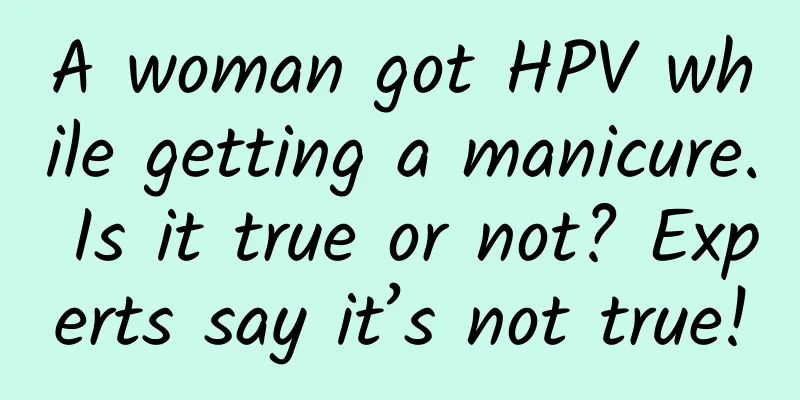A woman got HPV while getting a manicure. Is it true or not? Experts say it’s not true!

|
Recently, the news that manicures may cause infection with the sexually transmitted disease human papillomavirus (HPV) has attracted widespread attention. Ms. Wu, 22, found transparent small bags growing between her fingers after having a manicure, and was diagnosed with common warts caused by the HPV virus. Dermatologists at Jiangsu Provincial Hospital of Traditional Chinese Medicine pointed out that although there may be a risk of cross-infection with manicure tools, the "warts" growing next to the nails are not sexually transmitted infections. This type of common wart is different from the "cauliflower"-like lesions that occur in the cervix, external genitalia and other parts in terms of infection route, clinical manifestations and consequences. Experts emphasize that beauty lovers do not need to panic, but they should also pay attention to the possible harm that formaldehyde in manicure ingredients may cause to people with poor resistance. The difference between common warts and cauliflower-like lesions on the cervix, external genitalia, etc. Although both common warts and cauliflower lesions that occur in the cervix and external genitalia are caused by HPV, they differ significantly in many aspects: 1. Infection form: Common warts are mainly spread through direct skin-to-skin contact and are commonly seen in public bathrooms, swimming pools, and other places. The "cauliflower"-like lesions on the cervix, external genitalia, etc. are mainly transmitted through sexual contact and are a type of sexually transmitted infection. 2. Clinical manifestations: Common warts usually appear as rough, hardened skin growths that are close in color to normal skin and may have a papillary or flat appearance. Cauliflower-like lesions are more common on the mucosal surface, presenting as cauliflower-like or papillary protrusions that may be red or gray in color and are more characteristic. 3. Impact on health: Common warts generally do not develop into cancer and have relatively little impact on health. The cauliflower-like lesions of the cervix and external genitalia have a potential risk of cancer, especially infection caused by high-risk HPV, which may lead to serious diseases such as cervical cancer and genital cancer. 4. Treatment methods: Common warts are relatively easy to treat and can be removed through methods such as cryotherapy, laser treatment or surgical excision. Treatment of cauliflower-like lesions may be more complex and may require multiple interventions, including medical therapy and surgical treatment . The ingredients and hazards of manicure Common ingredients in nail products include acrylates, formaldehyde, toluene, tricresyl phosphate, fragrances and pigments. Acrylates are the main ingredients of nail gels and false nail adhesives. They form a hard surface after curing, but may irritate some people's skin. Formaldehyde is a preservative that was once widely used in nail products. It can help maintain the stability of the product and prevent microbial growth, but it is harmful to the human body and may cause skin allergies and respiratory irritation. It is listed as a Class 1 carcinogen by the International Agency for Research on Cancer . Toluene is an organic solvent used in nail polish to help dissolve other ingredients and make the nail polish evenly applied, but long-term exposure to toluene may be harmful to the nervous system. Tricresyl phosphate is a plasticizer used to increase the flexibility of nail polish and prevent it from becoming brittle, but it may affect the endocrine system, and long-term exposure to high concentrations of TCP may be harmful to health. Not only that, many nail products also contain fragrances and pigments to provide attractive colors and smells, some of which may cause skin allergic reactions. Exposure to formaldehyde in nail products may cause a range of adverse health effects, including skin allergies, respiratory irritation , and more serious health problems that may result from long-term exposure. At the same time, frequent manicures may damage nails, making them thinner and more fragile, and may even cause infections such as paronychia. It is worth noting that if nail tools are not thoroughly disinfected, they may carry bacteria, fungi and viruses, increasing the risk of cross-infection. How to avoid bacterial infection when doing manicure 1. Choose a reputable nail salon: Make sure the nail salon has strict disinfection procedures and equipment. 2. Bring your own tools: Use personal nail tools as much as possible to reduce the risk of cross infection. 3. Pay attention to hygiene: Wash your hands thoroughly before and after manicure and keep the area around your nails clean. 4. Regular check-ups: If you find any abnormalities in your nails or skin, seek medical attention immediately. 5. Moderate manicure: Avoid excessive manicure and give your nails proper rest and recovery time. |
>>: The geological code of "Flame Mountain"
Recommend
What are the effects and functions of small flying grass?
Small flying grass is the name of a Chinese medic...
The efficacy and function of Pseudotumorhynchus pubescens
Pseudotoma fern is a very common Chinese medicine...
The efficacy and function of Vita
Vita is a very nutritious and precious medicinal ...
What impact does collective narcissism have on society?
© Caravaggio/The Atlantic Leviathan Press: I pers...
Baldness treatment upgraded: With the help of gene editing, hairless mice grow human hair!
Written by: Hao Jing Editor: Kou Jianchao Layout:...
The efficacy and function of yellow peel on goose palm
I wonder if you have ever heard of the yellow ski...
Can't eat Longkou vermicelli on an empty stomach? Netizens are shocked! This is what the doctor said
Recently, a netizen posted a message saying: &quo...
Ouch! A mouse is pulling a winter melon!
Audit expert: Li Weiyang Well-known science write...
The efficacy and function of Citrus aurantium root bark
The essence of traditional Chinese medicine is to...
The efficacy and function of Thousand Needle Thread Grass
For many Chinese people, traditional Chinese medi...
National pharyngitis? COVID-19 and influenza A co-circulation? How to protect yourself during holidays?
Editor: Muzi...
The childhood snack "shredded figs" has nothing to do with figs?
I believe that for those born in the 1980s, the l...
How to prevent wolfberry poisoning
In the past, when life was hard, people always wo...
Is Shanghai’s beverage “nutrition grading” healthier?
Recently, some beverages in Shanghai have begun t...
![The efficacy and function of wolfberry leaves [picture]](/upload/images/67ca6f4a63c2f.webp)








